Trees, the showmen of the winter garden
Trees are the winter showmen of the garden, coming into their own just as the days are getting shorter and the light levels are falling. By November many will have dropped their leaves to reveal a fine winter tracery above a textured trunk, providing a sculpture all of their own when backlit by low winter sunshine. This creeps through branches and stems, creating a magic lantern pattern of light and shade, as winter arrives. Touch the trunk and it’s like stroking a hibernating animal because warmth penetrates the fingers, so trees are vital for gardeners. They’re the beating heart of any good garden.
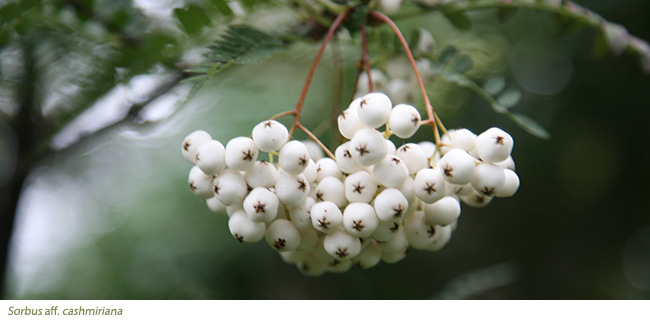
This should be enough reason for us all to want trees in our gardens, but they also benefit other plants throughout the year, because the network of roots dries out the soil and warms the ground around them. Spring bulbs and woodlanders don’t get waterlogged by wintry weather and they flower earlier as a result. The benign, overhead canopy stops the worst of the weather from above, keeping off hard frosts, so trees are life enhancers. But most important of all, trees offer scale and substance, putting the rest of the garden into context. Without them understorey planting looks like a bad multi-coloured carpet so, however small your garden, choice trees are a vital part.
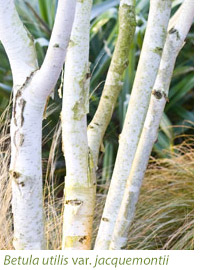 Don’t tuck them away in dank corners. Always give them a prominent position where winter sun can enhance them. The showiest are definitely the Himalayan and Chinese birches because they provide a pale trunk and an overhead besom of dark twiggy growth, just as though an artist had used chalk and charcoal in the same sketch. Stark white bark glows in winter light and makes the perfect backdrop for brighter flowers such as spring-flowering pink Cyclamen coum, or rich red or sooty black hellebores. Betula utilis var. jacquemontii ‘Doorenbos’ is an exceptional Dutch selection that develops white bark within three years - much sooner than most. Evergreens also shine planted close by, such as the scented Christmas box Sarcococca confusa, or hardy ferns such as polystichums. Rich evergreens will look warmer and more substantial planted close to pale birch bark.
Don’t tuck them away in dank corners. Always give them a prominent position where winter sun can enhance them. The showiest are definitely the Himalayan and Chinese birches because they provide a pale trunk and an overhead besom of dark twiggy growth, just as though an artist had used chalk and charcoal in the same sketch. Stark white bark glows in winter light and makes the perfect backdrop for brighter flowers such as spring-flowering pink Cyclamen coum, or rich red or sooty black hellebores. Betula utilis var. jacquemontii ‘Doorenbos’ is an exceptional Dutch selection that develops white bark within three years - much sooner than most. Evergreens also shine planted close by, such as the scented Christmas box Sarcococca confusa, or hardy ferns such as polystichums. Rich evergreens will look warmer and more substantial planted close to pale birch bark.
The name Grayswood, taken from the Surrey garden where these trees appeared, highlights two important birches with silky bark in slightly different colours. ‘Grayswood Ghost’ has a pearl-grey rather ghostly trunk and exceptional glossy green foliage on a well-shaped tree. ‘Grayswood Hill’, a form of Erman’s birch (B. ermanii), is a species from China that’s softer on the eye with creamy bark patterned in chestnut. The heart-shaped leaves have serrated edges, rather like crinkle-cut crisps, and they turn light butter-yellow in autumn. Both of these slow growing Grayswood trees take five years or so to develop their stunning bark, but they are worth the wait. Most birches are shallow-rooted, so don’t dig deeply round them, and those lovely trunks can be made more stunning by a once a year wash in autumn, with plain water and a car sponge, to remove any algae.
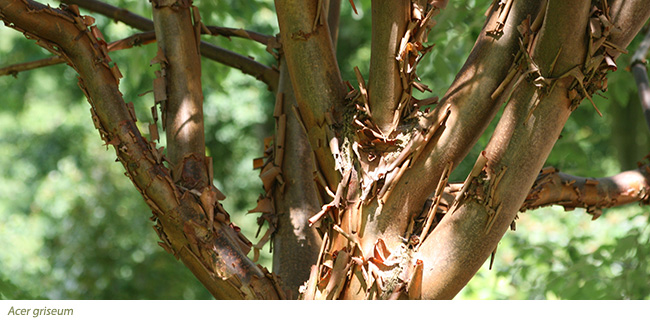
Some stunning trees with ragged bark also shine in winter, when sun picks up the rough texture. Acer griseum, the Chinese paperbark maple, has shaggy cinnamon-coloured bark that looks warm in winter light. It’s a slow growing tree, eventually reaching 10ft after many years, so it’s a perfect choice for a small space. It grows on chalk and on alkaline soil - something many acers resent. Although very hardy, it makes a better tree in a sheltered site, and the upward-facing canopy always looks rather like an umbrella blown inside out. Like many Chinese and Asian trees and shrubs, it prefers summer rain to winter rain.
If you love Acer palmatum it may be best to grow them in containers of ericaceous compost, unless you can spot them growing in the ground in ordinary gardens near you. They need neutral or acid soil to thrive and dislike alkaline conditions. 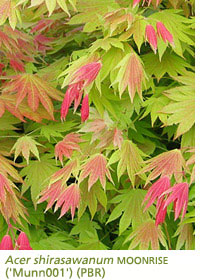 Left to their own devices they form bonsai-like shrubs with intricate shapes, often wider than taller, and they suit containers well. Most named forms have fingered foliage and many change colour throughout the year. A new golden acer with scorch-free foliage, called Acer shirasawanum MOONRISE ('Munn001') (PBR), is a breakthrough variety both for hardiness and sun resistance. It was discovered by Carl Munn of Oregon as a chance seedling and has become a worldwide favourite. The new carmine spring growth turns to chartreuse in summer and then develops red and orange tones in autumn.
Left to their own devices they form bonsai-like shrubs with intricate shapes, often wider than taller, and they suit containers well. Most named forms have fingered foliage and many change colour throughout the year. A new golden acer with scorch-free foliage, called Acer shirasawanum MOONRISE ('Munn001') (PBR), is a breakthrough variety both for hardiness and sun resistance. It was discovered by Carl Munn of Oregon as a chance seedling and has become a worldwide favourite. The new carmine spring growth turns to chartreuse in summer and then develops red and orange tones in autumn.
All acers need a sheltered site because in the wild they are understorey trees protected by an overhead canopy provided by much larger trees. So always find them a good position, one that that avoids frost and full sun, and they’ll add a wonderful touch of the orient to your garden. Excellent award-winning varieties include ‘Sango-kaku’, which has vibrant coral-red bare stems and pale green leaves that turn gold in autumn. ‘Katsura’ has five-lobed orange-yellow leaves that intensify in autumn and ‘Garnet’ has very finely cut plum coloured foliage. Once mature, their winter skeletons are elaborate and intricate, so they are trees for every season.
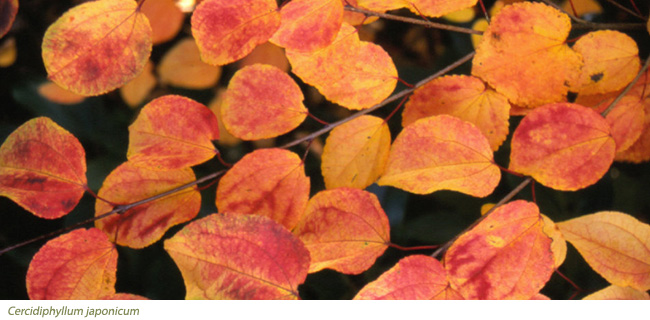
Or you may prefer to plant the real Katsura tree (Cercidiphyllum japonicum), although this forms a large tree in time, reaching 20 m (65ft). The small heart-shaped leaves turn pink to crimson in autumn and some trees produce a distinctive burnt-toffee smell on still warm autumnal days. Like candy floss it wafts through the air for several yards. The small leaves are held on fine almost spidery dark stems, so it’s a delicate thing in winter.
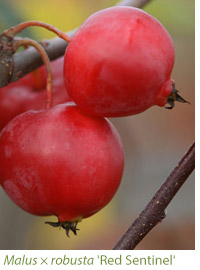 When it comes to fruitfulness there are lots of trees that hang on to their fruits in winter and some red-fruited crab apples are resplendent in winter light. The healthy crab apple, M. x robusta ‘Red Sentinel’, bears clusters that hang like bunches of red cherries. These festoon the branches into January, so you can normally cut for Christmas decorations, but do keep the branches damp and cool. Foraging fieldfares and redwings strip the fruit in January and February, and very entertaining they are, and then white blossom follows in spring. Crab apples (forms of Malus) are small enough for most gardens and they provide spring blossom and colourful fruit. They also cross-pollinate apple crops, so they are highly useful in gardens.
Some sorbus trees also produce berries that endure into winter. Sorbus commixta ‘Embley’ is a refined rowan, bearing airy clusters of translucent red berries and intricate foliage made up of 13 leaflets. It’s upright too, but there are pink berried forms and these dainty trees have cool green foliage, with jade and grey overtones to flatter the fruit. ‘Eastern Promise’ has fern-like foliage in cool green and full clusters of rose-pink fruits. These fruits generally persist through winter in most years and, if you underplant one with plummy pink hellebores, it’s a showstopper.
When it comes to fruitfulness there are lots of trees that hang on to their fruits in winter and some red-fruited crab apples are resplendent in winter light. The healthy crab apple, M. x robusta ‘Red Sentinel’, bears clusters that hang like bunches of red cherries. These festoon the branches into January, so you can normally cut for Christmas decorations, but do keep the branches damp and cool. Foraging fieldfares and redwings strip the fruit in January and February, and very entertaining they are, and then white blossom follows in spring. Crab apples (forms of Malus) are small enough for most gardens and they provide spring blossom and colourful fruit. They also cross-pollinate apple crops, so they are highly useful in gardens.
Some sorbus trees also produce berries that endure into winter. Sorbus commixta ‘Embley’ is a refined rowan, bearing airy clusters of translucent red berries and intricate foliage made up of 13 leaflets. It’s upright too, but there are pink berried forms and these dainty trees have cool green foliage, with jade and grey overtones to flatter the fruit. ‘Eastern Promise’ has fern-like foliage in cool green and full clusters of rose-pink fruits. These fruits generally persist through winter in most years and, if you underplant one with plummy pink hellebores, it’s a showstopper.
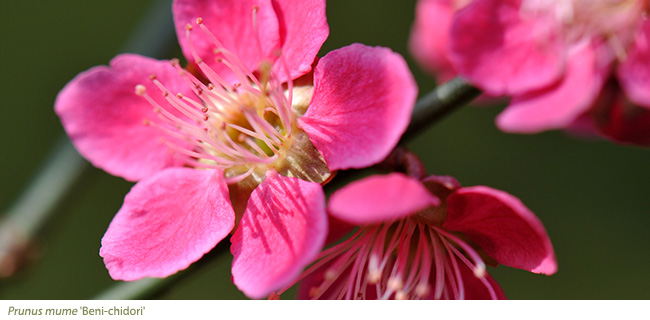
When it comes to blossom some members of the cherry family offer very early flowers and one of the best is Prunus mume ‘Beni-chidori’ a small tree often called the Japanese apricot. Small button-sized, red-pink flowers appear on dark bare branches by the end of February and Beni-chidore is Japanese for ‘the flight of the red plovers’. Even smaller in stature is Prunus ‘The Bride’ and it’s covered in blush-pink flowers that have almost red middles so it’s always subtle and pretty. In mid-spring ‘The Bride’ drips with flower and it’s often planted as a specimen in lawns of small gardens.
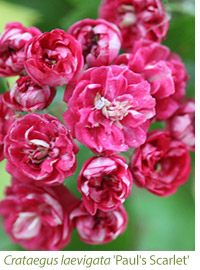 If you’ve got more space, add a touch of the country with an ornamental hawthorn in the shape of Crataegus laevigata ‘Paul’s Scarlet’, a double flowered pink form of the midland thorn. Each flower is like a miniature bright pink rose and this tree often makes a wide shape with a flat top, so it can make a huge impact when it flowers in early May. Haws follow which please the birds. There is also a less pink form called Crataegus laevigata 'Rosea Flore Pleno’ if you’re more subdued.
If you’ve got more space, add a touch of the country with an ornamental hawthorn in the shape of Crataegus laevigata ‘Paul’s Scarlet’, a double flowered pink form of the midland thorn. Each flower is like a miniature bright pink rose and this tree often makes a wide shape with a flat top, so it can make a huge impact when it flowers in early May. Haws follow which please the birds. There is also a less pink form called Crataegus laevigata 'Rosea Flore Pleno’ if you’re more subdued.
Whichever tree you choose it will add structure and form to your garden, and delight you through the seasons.











